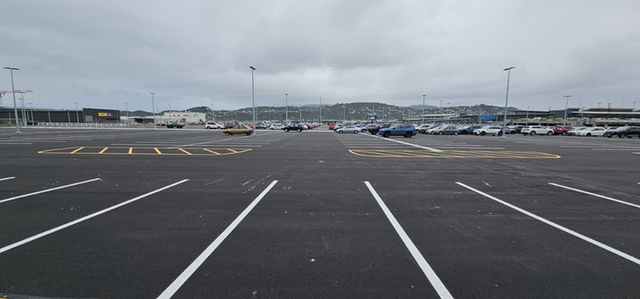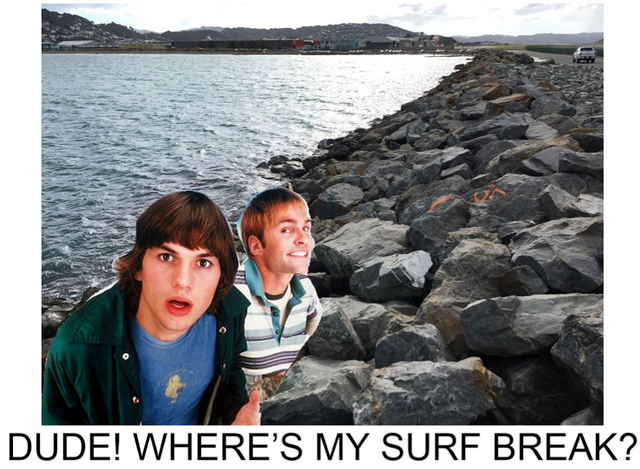Lyall Bay and Transport
-
-

East Side Area Carpark and storage area
- Guardians of the Bays
- Photo: Lyall Bay 22 April 2025 – https://www.facebook.com/lyallbaywgtn The East Side Area golf course land has been converted from a golf course green into two hectares of hard black asphalt for 800 cars. The proposal is for boundary treatments, to surround this area with a walking track, and planting. More information can be found inContinue reading "East Side Area Carpark and storage area"
- Accepted from Guardians of the Bays posts by feedreader
- Tagged as:
- lyall-bay
Lyall Bay, Wellington, Wellington City, Wellington, New Zealand/Aotearoa (OpenStreetMap)
-
-
-

Wellington Airport Seawall Renewal
- Guardians of the Bays
- Wellington Airport’s is consulting the community on the renewal of the southern and Lyall Bay seawalls and breakwater. The airport has been talking about this for ages. We are now able to tell them we don’t want an airport extension, the seawall renewal needs to keep within the boundaries they already have and climate adaptation […]
- Accepted from Guardians of the Bays posts by feedreader
- Tagged as:
- lyall-bay
Lyall Bay, Wellington, Wellington City, Wellington, New Zealand/Aotearoa (OpenStreetMap)
-
-
-
Scoop – Surfers opposing runway extension, defending Lyall Bay
- Guardians of the Bays
- Originally published on Scoop News from WPW The Surfbreak Protection Society, New Zealand’s national surfers’ environmental organisation, is opposing Wellington Airport’s application for resource consent to extend its runway because of the impact it will have on surfing and the surfing environment on Wellington’s South Coast.
- Accepted from Guardians of the Bays posts
- Tagged as:
- lyall-bay
- runway-extension
Lyall Bay, Wellington, Wellington City, Wellington, New Zealand/Aotearoa (OpenStreetMap)
-
-
-

Re-blog surfbreak protection society: “dude, where’s my surf break?”
- Guardians of the Bays
- By Michael Gunson WIAL’s grand plan for Lyall Bay’s surf breaks: The Surf break Protection Society (SPS) would like to think that its submission opposing Wellington International Airport Limited (WIAL)’s airport extension and artificial swell focus reef is the cause of the airport company’s decision to suspend and revise its consent application.
- Accepted from Guardians of the Bays posts
- Tagged as:
- lyall-bay
Lyall Bay, Wellington, Wellington City, Wellington, New Zealand/Aotearoa (OpenStreetMap)
-
-
-

RE-BLOG SURFBREAK PROTECTION SOCIETY: Wellington Airport Calling the Tune on Lyall Bay’s Corner surf break
- Guardians of the Bays
- by Michael Gunson Link here Revelations have emerged that Wellington International Airport Ltd has been responsible for alterations to the Moa Point Road sea wall in Lyall Bay.
- Accepted from Guardians of the Bays posts
- Tagged as:
- lyall-bay
Lyall Bay, Wellington, Wellington City, Wellington, New Zealand/Aotearoa (OpenStreetMap)
-
-
-
REBLOG ORA TAIAO: Call for urgent health check on Wellington runway extension plans
- Guardians of the Bays
- OraTaiao: The NZ Climate and Health Council is calling for an independent health check on Wellington Airport’s expensive plans to extend the runway into Lyall Bay.
- Accepted from Guardians of the Bays posts
- Tagged as:
- lyall-bay
- runway-extension
Lyall Bay, Wellington, Wellington City, Wellington, New Zealand/Aotearoa (OpenStreetMap)
-
-
-

REBLOG SURFBREAK PROTECTION SOCIETY: Lyall Bay surf breaks at “substantial risk” from runway extension plan
- Guardians of the Bays
- The Surfbreak Protection Society (SPS) is very concerned that Wellington International Airport Ltd is attempting to railroad through its runway extension by way of the Environment Court, seeing it has not yet yall Bay made convincing arguments through articulated scientific-based debate.
- Accepted from Guardians of the Bays posts
- Tagged as:
- lyall-bay
- runway-extension
Lyall Bay, Wellington, Wellington City, Wellington, New Zealand/Aotearoa (OpenStreetMap)
-
-
-
REBLOG Croaking Cassandra: Further thoughts on the airport Part 1
- Guardians of the Bays
- Shortly after the release of the cost-benefit analysis of the proposed Wellington airport runway extension, prepared by Sapere for Wellington International Airport Limited (WIAL) I wrote a post in which I posed the question “If they build it, what if no one comes?” Since that post, I’ve been to one of the open day/public consultation meetings, have read and thought about the documents more thoroughly, and have read various pieces written by others, including the new one by Ian Harrison that I linked to yesterday. I have also had some engagement with Sapere and WIAL, which has helped to sharpen my sense of what the issues really are. The cost-benefit analysis is not a business case document. It has been prepared in support of a resource consent application. What I hadn’t known when I wrote earlier (and was advised of by Sapere) is that under the RMA the applicants will need to be able to demonstrate national benefits to get permission to fill in some more of Lyall Bay, to extend the runway. I’m sure that the cost-benefit analysis is not serving as a business case for Infratil, the major shareholder in WIAL. But since this project is generally accepted to be viable only if there is significant public funding, and any such funding can only be defended if there would be material net public benefits , the Sapere cost-benefit analysis is by default serving as something of a business case at present. If the numbers don’t stack up, neither the Wellington region councils nor central government should be putting any money into the project (beyond WIAL’s resources, and of course Wellington City Council is a 34 per cent shareholder in WIAL). In this post, I will offer a few thoughts on the plausibility of the assumed increase in international passenger traffic to/from New Zealand as a result of the extension. Extending the runway at Wellington airport could materially reduce the cost of some forms of international travel in and out of Wellington. If long-haul flights were offered, lower costs could result by reducing the time taken (eg. by eliminating the one hour flight to Auckland and the stopover time in Auckland, it might reduce the total time for a trip to Singapore (and onward points) by perhaps 2.5 hours). For those travelling anyway, those gains could be material – time has an opportunity cost. In addition, by allowing long-haul aircraft to fly into Wellington, the direct cost of international airfares in and out of Wellington could also be expected to fall – quite materially, if the numbers Sapere quotes are correct. Those gains apply not just to long haul routes themselves – a Wellington-Singapore direct fare should be materially cheaper than the current options via Auckland, Christchurch or Sydney – but also to trans-Tasman flights, as the longer runway would also facilitate used of wide-bodied aircraft on trans-Tasman routes (as for examples, the Emirates flights between Christchurch and Australia). Of course, simply building the runway extension does not bring about any of these savings. They depend on airlines finding it profitable to run additional services. And although international air travel has increased enormously to and from New Zealand in recent decades, provincial New Zealand is littered with the dreams of local authorities (airport owners) with aspirations to have an international airport. New Zealand has plenty of attractive places, but one main international airport. Wellington, of course, has a significant business market, and business travel is typically much more profitable for airlines than leisure travel. And unlike the predominantly leisure travel into Christchurch, the Wellington business travel probably isn’t very seasonal. So the idea the long haul flights into Wellington could be viable isn’t self-evidently absurd. But, on the other hand, the economic cost of making such flights technically feasible – lengthening the runway – is far higher than in many other places. At $1m a metre, it is considerably more costly than putting some asphalt on some more grassy fields in Christchurch. Wellington isn’t a natural place for a long-haul international airport. The WIAL proposal uses modelling by international consultants to estimate likely growth in traffic and passenger numbers with and without the extension. There are some questions about the baseline forecast, including for example around the potential future impact of climate change mitigation policies. But my main interest is the difference between these two – the increase in traffic that would result from the runway extension itself. It is hard to pick one’s way through all the numbers, but the bottom line appears to be that the cost-benefit analysis is done on the basis that by 2060 there will be an additional 400000 foreign international passengers per annum arriving in Wellington, and an additional 200000 New Zealand international departures per annum through Wellington[1]. Many of these are people who would otherwise have travelled via Auckland or Christchurch, so that the net gain in international travel numbers to New Zealand is around 200000, with an additional 100000 or so New Zealanders travelling abroad. Many of the gains are forecast to occur early in the period. Thus, by 2035, the analysis assumes an annual net gain to New Zealand of around 125000 international visitors (relative to the no-extension baseline). How plausible is this? The various reports highlight the phenomenon of “market stimulation” – putting on new air services tends to stimulate total passenger numbers. That shouldn’t be surprising. Not only do point-to-point services lower the cost of visiting a particular place, but marketing expenditure raises awareness of the destinations concerned. On the other hand, one can’t just take for granted that such market stimulation will render long haul flights into and out of Wellington viable. After all, there are plenty of cities around the world with few or no long haul flights. Closer to home, Rotorua is an attractive tourist destination and can’t sustain direct flights even to Sydney. What of Wellington? The modelling exercise involves lowering the cost of foreigners visiting Wellington – to some extent artificially, because the costs of providing the longer runway are not passed back in additional charges to those using long haul flights – but not the cost of them visiting New Zealand (since Auckland and Christchurch fares would stay largely unchanged). Any long-haul flights into Wellington will almost certainly be from cities that already have flights to Auckland (and possibly to Christchurch). Is it really plausible that an additional 200000 people per annum (or even 125000 by 2035) will visit New Zealand simply because they can fly direct to Wellington, or (in respect of trans-Tasman traffic) fly into Wellington more cheaply than previously? Perhaps I’m excessively negative on Wellington. I reckon it is a nice place for a weekend, but not a destination that many long haul leisure travellers would choose. What is there to do after the first two days? And there is little or nothing else in the rest of the bottom of the North Island. So it is plausible that lower fares resulting from additional competition would attract more weekend visitors from Australia. But no one is going to come for a weekend in Wellington all the way from China or Los Angeles. And since the principal attractions of New Zealand are either in the upper North Island or the South Island, how many more people are likely to come to New Zealand just because they can choose Wellington as the gateway for their New Zealand holiday? And what of New Zealanders travelling abroad? Since the costs of Wellingtonians (and others in the nearby areas) getting to desirable destinations abroad would be cheaper if there were direct flights from Wellington, it is credible that the total number of New Zealand overseas travellers would increase. In fact, whereas the modelling suggests twice as many new foreign visitors as new New Zealand international travellers (and in total there are twice as many international visitors to New Zealand as travelling New Zealanders), in this case I wonder if the putative new routes would not be more attractive to New Zealanders than to foreigners? One can illustrate the point with a deliberately absurd example: put on long haul international flights to Palmerston North, and they would be quite attractive to people in Manawatu (much easier/cheaper to get to desirable places like New York or London) but not very attractive at all to foreigners (for whom Manawatu has few attractions). But even if wide-bodied aircraft flights from Wellington did make overseas travel more attractive to New Zealanders, is the effect really large enough to be equivalent to one more trip every year for every 10 people in Wellington and its hinterland? And would the effect still be remotely that large if passengers (users) had to cover the cost of providing the longer runway (which should really be the default option)? Reasonable people can differ on these issues. In my discussions, a lot seems to turn on just how attractive people think Wellington is. I’m pretty sceptical that long haul tourists will ever come to New Zealand to see cities. Perhaps if one is thinking of visiting New Zealand cities, Wellington is more attractive than our other cities, but even if so Wellington still has the feel of being a logical gateway to nowhere much. It isn’t an obvious starting point for a “whole of New Zealand” trip, or a North Island one (given that most of the attractions are further north), or a South Island one. So I’m left (a) sceptical that the net addition to visitor numbers to New Zealand will be as large as the analysis assumes even if the users don’t bear the costs, and (b) suspecting that the boost to the demand for New Zealanders to travel abroad might be greater than the boost to the demand for foreigners to visit New Zealand. On that latter point, the experts point out that they assume that the new long haul services will be provided by foreign airlines, and that the evidence of recent new air services to New Zealand provided by foreign airlines is that they disproportionately boost the number of foreigners travelling. I have no reason to doubt the numbers, but I still wonder if the same result would apply to routes into Wellington. New flights into Auckland are often the first direct flights offered into New Zealand (as a whole) from that city or country. My impression is that “New Zealand” is the destination marketed to long haul passengers. But direct flights to/from Wellington do more to open up the world (more cheaply) to Wellingtonians than they do to open New Zealand to foreigners. And if so, would the foreign airlines be keen to offer the Wellington services at all? This post has been about the sort of increased passenger numbers that might be expected if the runway was extended. In some sense, that should be largely an issue for WIAL. If they can extend their capacity and attract sufficient users at a price that covers the cost of capital of WIAL and its shareholders, the rest of us might not care much (I’m not much bothered about environmental issues, although my family enjoys the waves at Lyall Bay beach). But the cost-benefit analysis being used to lure ratepayers and taxpayers into funding much of the proposed expansion suggests that there are very large economic benefits to New Zealand which cannot be captured directly by airlines or airports. I think they are wrong, and my next post will explain why. [1] From tables 5.11 and 5.12 in the InterVISTAS report.
- Accepted from Guardians of the Bays posts
- Tagged as:
- consultation
- fares
- runway-extension
- lyall-bay
Lyall Bay, Wellington, Wellington City, Wellington, New Zealand/Aotearoa (OpenStreetMap)
-
-
-
Building a road and saving 30 seconds
- Wellington Scoop
- One of the most extraordinary things about plans to bulldoze a road through the pristine Takapu Valley is the claim about how much time will be saved. They’re counting the savings in seconds. The claim is found in an Appendix to the controversial report in which the chief executives of regional councils tell their mayors that they ought to support a road through the valley.
- Accepted from Wellington Scoop features
- Tagged as:
- oriental-bay
- tawa
- khandallah
- makara
- worser-bay
- stokes-valley
- mount-cook
- island-bay
- hataitai
- civic-square
- ngaio
- northland
- roseneath
- newtown
- thorndon
- hutt-valley
- titahi-bay
- paraparaumu
- wadestown
- miramar
- porirua
- johnsonville
- wainuiomata
- lyall-bay
- wilton
- begonia-house
- paremata
- eastbourne
- karori
- mount-victoria
- kelburn
- kilbirnie
- berhampore
- aro-valley
- brooklyn
- wairarapa
- seatoun
- cuba-street
- waterfront
- newlands
- takapu-valley
Karori, Wellington, New Zealand (OpenStreetMap)
-
-
-
We have moved !!
- Wellington Aero Club
- Wellington Aero Club has shifted daily operations to our new hangar and offices at 24 George Bolt St, Rongotai, Wellington. The new location is easy to find, right next to the big red The Warehouse at the Lyall Bay shopping centre. Daily flying will now all be conducted from our new location, and being located right [...]
- Submitted by tonytw1
- Tagged as:
- lyall-bay
Lyall Bay, Wellington, Wellington City, Wellington, New Zealand/Aotearoa (OpenStreetMap)
-


